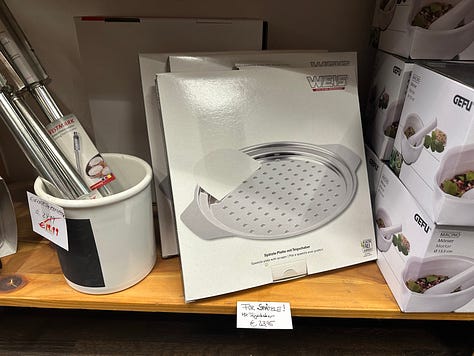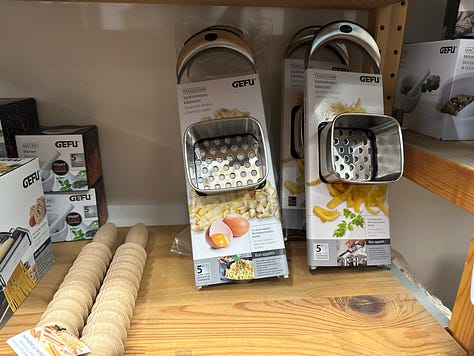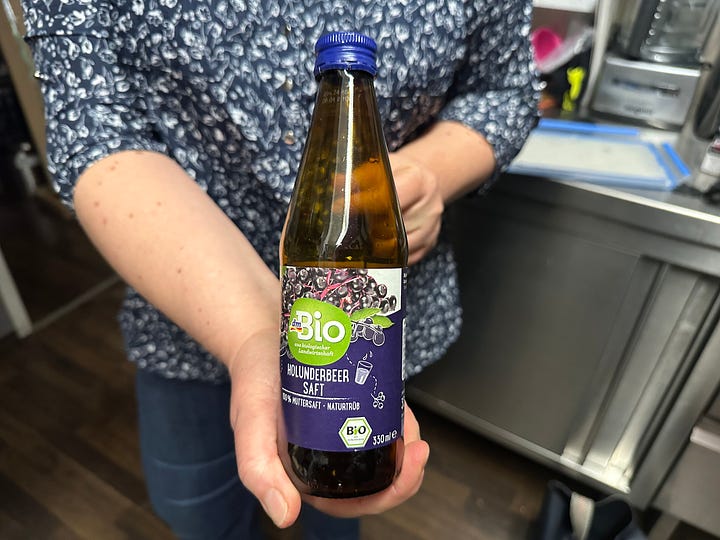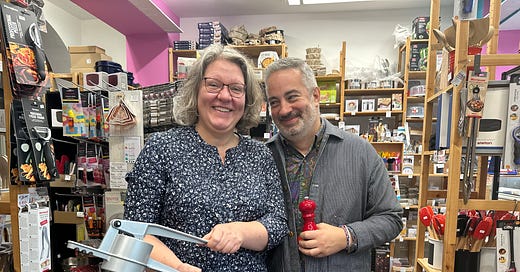Let's Talk About Classic German Cooking
Kochtail's Joe Diliberto and Maja Welker - Elderberry Apple Soup with Semolina Dumplings
When you write a cookbook (or two) about German cooking, almost everyone you meet will have an opinion about their favorite German recipes. In the run-up to publication of Classic German Cooking, I thought it’d be fun to talk to friends and acquaintances in Berlin and beyond about their favorite German recipes, and maybe even get a bonus recipe here or there, if someone’s generous enough to share. If you’re a passionate cookbook reader like me, you know that the stories around food are often at least as interesting, if not more, than the food itself. This week I’m featuring Joe Diliberto and Maja Welker and her elderberry-apple soup.
Joe Diliberto, the owner of Berlin’s best kitchen shop, Kochtail, is a dear friend of mine. Joe is from Wellesley, MA, and is an all-around hilarious dude with very good taste, especially in food, travel and kitchenware. In 2015, I introduced him to my friend Maja, who at the time was helping me test and develop recipes for Classic German Baking. Joe promptly hired her to work for him at the shop and they’ve been coworkers ever since. I visited Joe and Maja at Kochtail one morning before the shop opened to talk about German cooking.






Before we get to our conversation, I want to point out that Kochtail is a great resource for any utensil you might need for any classic German cooking. From all kinds of Spätzle equipment to asparagus peelers and pots to nutmeg graters and potato and mushroom brushes and boiled potato trident spears (for peeling!) to egg spoons to poppyseed grinders and so much more, Kochtail is a true Aladdin’s cave. Both Joe and Maja (and the store’s other employees) are super knowledgable about cooking and baking and are always down for advice and chat about good kitchen tools and how to use them. (Kochtail will ship outside of Germany, but contact them to discuss specifics.)






We met in the shop’s tiny kitchen, where Joe and his employees take turns providing lunch for each other. For our conversation, and for lunch for the others later on, Maja had made Fliederbeersuppe, also known as Holundersuppe, a warm elderberry soup with apple slices and semolina dumplings. We ate it while we talked and it was so good, tart and velvety. She generously agreed to share the recipe with all of you! Our conversation follows, translated from the German.
Wow, this is delicious! Is it breakfast, a sweet lunch or is it dessert?
Maja: I think this is on the border between sweet lunch and dessert.
Is it a family recipe?
Maja: I actually had to search for a recipe because we usually just eyeball it at home. Also, it’s been about 20 years since I last ate it. So I adapted it to the way I remember it being. It’s also really delicious served cold in the summertime. This isn’t pure elderberry juice, by the way, it’s mixed with apple juice to make it a little less bitter and sour. I made it once for Bertram1 with pure elderberry juice and it was just too strong.
Well, I like it a lot.
Maja: I’m not sure if it’d be enough for a proper lunch without anything else, I mean, of course, depending on how many little dumplings you put in your bowl. When I was little, they was always served together in one pot and my sister and I always tried to get as many dumplings as possible into the ladle when we helped ourselves, without the grownups noticing, because you weren’t allowed to just fish them out.
The consistency is wonderful. It’s just a little bit thickened—
Maja: Yes, so that it remains a soup rather than a pudding.
Joe, how many years have you lived in Germany?
Joe: I think in total something like 21. Originally I came to Munich to study. So my first introduction to German food was very much southern German food, which still has the bigger place in my heart. So, yeah, to me German food is Käsespätzle, Knödel, Schnitzel. This may or may not be relevant, but having come here in the 90s, to me German food was also Turkish food. I didn't really know Turkish food.
And today, are there certain dishes that you really crave or that you're excited to eat when it's a seasonal thing?
Well, it's funny you say that because I do love the seasonality. Whether you're in a supermarket or at the farmer's market or even a restaurant, it's always so obvious what is seasonal. Right now it's chanterelles, which I love.
Do you cook anything German at home?
Joe: Kräuterquark2! I eat with everything: boiled potatoes, bread, fish sticks, everything.
How about you, Maja, you’re from northern Germany.
Maja: From the Lüneburger Heide.
You’re married to a southern German.
Maja: Exactly. And my mother was from Frankfurt, so there were also some southern influences in our home. From our point of view, Frankfurt was where southern Germany began, well, technically it was Giessen. ;)
To me, you embody the art of German cooking. You are so knowledgable and you have so many delicious recipes up your sleeve. Not just baking! Can you tell us a little bit about how you came to fall in love with cooking or how it became such a passion for you?
Maja: My mother was a very diligent home cook. I was always interested in food and so I liked joining her in the kitchen. My mother was a teacher so she was always home at lunchtime3 and she always cooked. At breakfast, we were always asked: what do you want to eat today? Our answer was always, something yummy! We had a big garden and there were beans in the summer and sometimes there were weeks of eating only zucchini and of course potatoes.
Did you always eat a warm meal at lunch and a cold meal at dinner?
Maja: Yes. My father was also a teacher so he was home at lunchtime too. I didn’t even know that others might want to eat a hot meal in the evening. That was, for us, reserved only for the rare occasions when we ate in a restaurant or on a big holiday. My mother usually made soups and Eintöpfe4. Bean soup, potato soup. Sometimes we ate meat as part of a classic trio with a starchy side and a vegetable. Stewed cucumbers, creamed beans, that kind of thing.
Would you say that your family meals had sort of more Prussian influences than southern German influences?
Maja: Honestly, it was quite a mix. We didn’t eat potatoes with every meal, for example. Quite often, we ate rice or noodles. We also ate sweet main courses semi-frequently, because my father loved them. My mother didn’t; she always needed to eat a cheese or ham sandwich afterwards. But she cooked them anyway, also because they were simple and quick meals.
When you ate a sweet meal, did you have salad or a soup along with it?
Maja: Salad, yes, but not soup. Oh wait, except for one recipe that my mother grew up eating at her grandparents’ house: potato soup with apple fritters served alongside, not afterward.
When you met Bertram, who comes from Swabia, were you surprised by your culinary differences?
Maja: A little. But because my mother had cooked quite a bit of southern German food, I already knew some things. For example, my mother always made potato salad with broth rather than mayonnaise5. But what I found extremely odd was that he didn’t eat white asparagus with boiled potatoes, like God intended. Instead he ate them with a thin pancake called Kratzete. In the meantime, I’ve become a fan of it, but at the time, it just seemed wrong. White asparagus belongs with boiled potatoes!


Can you tell me a little bit more about what you made for us today?
Maja: The elderberry soup is a classic northern German dish. Elderberry grows wild everywhere. This dish is probably related to the Scandinavian tradition of fruit soups. And it’s so easy. It’s a great thing for the fall and winter, it warms you up when you come in from the rain or snow. Of course, you can just warm up elderberry juice and drink it hot like cider, but this turns it into a meal. You cook the juice with lemon peel, cinnamon and cloves, let it thicken a little, add some peeled, sliced apples, but only cook them for a little bit, so they retain a bit of bite and then add these little semolina dumplings.
It’s so, so delicious.
Maja: I’m so glad. I thought it was a good mid-morning snack. The boss was hoping for Schnitzel.
Well, then here’s my offer to you: I’ll have you over for a Schnitzel dinner, okay?
Joe: Let’s do it.
Maja Welker’s Elderberry-Apple Soup with Quark Dumplings
Serves 4 to 6
Note: Depending on your taste, you can vary the ratio of elderberry juice to apple juice. Pure elderberry juice is only for connoisseurs, but is the most authentic (and the healthiest!). You can also try 1 part elderberry juice to 2 to 3 parts apple juice. If necessary or desired, you can reduce the amount of sugar. The cornstarch quantity is also only an approximation. If you want a thicker soup—or if you want to serve it piping hot—use more; for a thinner soup, use less. The soup thickens slightly when it cools down, so you can also reduce the amount of cornstarch if serving the soup in summer, chilled.
For the dumplings:
500ml milk
1 vanilla bean
2 strips of lemon zest
Good pinch of salt
125 grams semolina (soft or durum wheat)
40 grams sugar, or to taste
30 grams unsalted butter
1 large egg
Salt for cooking
For the soup:
500ml pure elderberry juice
500ml apple juice
3 strips of lemon peel
1/2 cinnamon stick
2 cloves
1 small bay leaf
Good pinch of salt
Juice of one lemon
60 grams sugar, or to taste
2 Tbsp cornstarch
2 large, tart apples (like Boskoop or Cox Orange), peeled, cored and cut into 1/2 to 1/4-inch slices
First, make the dumplings: Place the milk, vanilla, lemon zest and salt in a medium saucepan over medium high heat. When it starts to simmer, whisk in the semolina and let simmer for about a minute while continuously whisking.
Remove the pan the heat and stir in the sugar and butter. Add the egg and whisk vigorously until well-combined. Set aside to cool.
Bring a large pot of water to boil over high heat and add a generous amount of salt (about as much as you would use for pasta water), then reduce the heat to a simmer. Using two damp spoons, shape the semolina mixture into small oval dumplings and drop them directly into the simmering water (if it is too awkward to use spoons and you don't necessarily want the classic oblong shape, you can also shape the mixture using a small ice cream scoop). To ensure that the dumplings cook more or less evenly, only cook about 6 to 8 at a time, increasing the heat until the water simmers again. Stir the pot occasionally so that the dumplings do not stick together. After a few minutes, they will rise to the surface of the water, then let them cook for another 3 to 4 minutes.
Remove them from the simmering water with a slotted spoon and place on a plate to cool. They will firm up as they cool. Repeat with the remaining batter until all of the dumplings are cooked.
Next, make the soup: Place the two juices, the lemon peel, cinnamon, cloves, bay leaf, salt and sugar in a stockpot and set over medium-high heat. While the mixture is heating up, place the cornstarch in a small bowl and add 2 to 3 tablespoons of the juice mixture, then whisk until smooth.
When the pot comes to a boil, whisk in the cornstarch slurry and bring back to the boil, stirring once. Then remove the pot from the heat. Slip the apple slices into the hot soup and let them infuse briefly.
The soup can be served hot, warm or chilled. Either place a few dumplings into each soup plate immediately before serving (this will keep them nice and white—and you can serve them more “fairly”) or place them directly in the soup.
Maja’s husband
Quark, a German fresh cheese, mixed with chopped herbs and some type of allium
In Germany, school traditionally ends at 1:00 pm, so children go home for lunch.
One-pot-stews.
Putting mayonnaise in potato salads is more northern German, while a hot vinegar-broth dressing is typical for southern German potato salads.






What a nice coincidence: I just had delicious Elderberry Apple Soup last weekend in Glückstadt. Its a tiny town not far from Hamburg at the river Elbe in Northern Germany. I went there for a weekend with my husband without the kids and it was lovely. We chose it on a whim, having no idea what we would see or do and ended up eating both evenings in a very lovely restaurant (Der kleine Heinrich) serving classic Northern German food. It was sooo good!. The soup was our dessert on the first evening and it was perfection. Only: My mother used to put Sago into the soup, which we kids called frog eggs. I missed those :-) Maybe I can use this recipe to try it out myself AND put the Froscheier in :-)
I would simply lose my mind in such an amazing shop! Can’t wait for the book!